
 EDITOR Tanya Fox ART DIRECTOR Brad Snow PUBLISHING SERVICES DIRECTOR Brenda Gallmeyer ASSOCIATE EDITOR Brooke Smith ASSISTANT ART DIRECTOR Nick Pierce COPY SUPERVISOR Deborah Morgan COPY EDITORS Mary ODonnell, Samantha Schneider TECHNICAL EDITOR Corene Painter PHOTOGRAPHY SUPERVISOR Tammy Christian PHOTO STYLISTS Tammy Liechty, Tammy Steiner PHOTOGRAPHY Matthew Owen PRODUCTION ARTIST SUPERVISOR Erin Augsburger GRAPHIC ARTIST Nicole Gage PRODUCTION ASSISTANTS Marj Morgan, Judy Neuenschwander ISBN: 978-1-59635-376-3 Printed in the USA 1 2 3 4 5 6 7 8 9 Copic Coloring Guide is published by DRG, 306 East Parr Road, Berne, IN 46711. Printed in USA. Copyright 2011 DRG. All rights reserved. This publication may not be reproduced in part or in whole without written permission from the publisher. RETAIL STORES: If you would like to carry this pattern book or any other DRG publications, visit DRGwholesale.com.
EDITOR Tanya Fox ART DIRECTOR Brad Snow PUBLISHING SERVICES DIRECTOR Brenda Gallmeyer ASSOCIATE EDITOR Brooke Smith ASSISTANT ART DIRECTOR Nick Pierce COPY SUPERVISOR Deborah Morgan COPY EDITORS Mary ODonnell, Samantha Schneider TECHNICAL EDITOR Corene Painter PHOTOGRAPHY SUPERVISOR Tammy Christian PHOTO STYLISTS Tammy Liechty, Tammy Steiner PHOTOGRAPHY Matthew Owen PRODUCTION ARTIST SUPERVISOR Erin Augsburger GRAPHIC ARTIST Nicole Gage PRODUCTION ASSISTANTS Marj Morgan, Judy Neuenschwander ISBN: 978-1-59635-376-3 Printed in the USA 1 2 3 4 5 6 7 8 9 Copic Coloring Guide is published by DRG, 306 East Parr Road, Berne, IN 46711. Printed in USA. Copyright 2011 DRG. All rights reserved. This publication may not be reproduced in part or in whole without written permission from the publisher. RETAIL STORES: If you would like to carry this pattern book or any other DRG publications, visit DRGwholesale.com.
Every effort has been made to ensure that the instructions in this publication are complete and accurate. We cannot, however, take responsibility for human error, typographical mistakes or variations in individual work. Please visit AnniesCustomerCare.com to check for pattern updates.
Table of Contents
Intro to Copic
Markers
I found I could say things with color and shapes that I couldnt say any other waythings I had no words for.~ Georgia OKeeffeThe Joy of Coloring
Coloring, at first glance, may seem childish, unimportant, silly evenan act that many of us did when we were young. But think backremember why you colored, and how you felt when you were doing it. For Marianne and me, coloring is an important aspect of our jobs, but its much more than that. Coloring is a form of communication, a way to gather the ideas from our heads and transfer them to paper, creating a visual image that is easily understood.
Coloring is also a form of relaxation. The act of coloring itself becomes a meditation that relieves stress, relaxes the body and clarifies thought processes. Coloring is something we both love and we want you to love it too. With the myriad of coloring mediums that are available, its easy to feel overwhelmed and even frustrated. Fortunately, Copic brand alcohol ink markers are easy tools to use! With the huge color selection and the clear-cut numbering system, theres no guesswork involved, so you can forget about the how and focus on the do. With the tips, techniques and projects in this book, we hope to lead you down the road to successful (and frustration-free) coloring ENJOY! Colleen and Marianne
Why Copic?
Its simple, really:- Top-quality product designed to be a lifelong art tool
- Variety of barrel styles to fit any budget/need
- Alcohol ink can be layered and blended without harming paper surface.
- Waterproof and acid free
- Ink formulas and colors consistent for over 25 years
- Low odor, nontoxic and environmentally friendly
- Works on multiple surfaces
- Refillable
- Replacement and optional nibs available
- Logical color-label system

Marker Styles
There are four styles of Copic markers to choose from.
Regardless of the style, the quality and ink are the same.



The Secret Code
Understanding the Copic Color System
These markers blend beautifully, but you need to be able to pick colors that work well together to get them to blend easily. Thats where the secret code comes in. The numbers and letters on the marker represent the three classifications within the Copic Color System.

Blending Rules
Use the following rules to pick colors that naturally work together and blend well. First, match the color letter(s)keeping the color family the same. Then match the color saturation numberkeeping the tone the same.
Lastly, pick color brightness numbers within 2 or 3 digits from each other. Example: B21, B24, B26. 

Product Compatibility
To get the best results from your Copic markers, its vital to use the right inks and papers. While we recommend X-Press It Blending Card and Memento Dye Inksand many of the samples in this book were created using thoseits important to do your own testing for product compatibility as everyones inking and coloring styles are different. Its often a matter of personal preference.
Testing Inks
Stamp image onto the paper; let dry completely.
Scribble over the stamped image with the Colorless Blender. Does the stamped ink bleed or feather? If yesits not a compatible ink. If nothen its a good ink to use with your Copic markers.
Testing Papers
Draw a circle with a pencil or compatible inking pen. Color up to the edges using a lot of ink, saturating your paper. Does the ink feather outside the lines? If yesthe paper may not be compatible.
If nothen its a good paper for your Copic marker use.
Testing Digital Images
Print your images as normal and test the printer ink in the same way you would stamping ink. If your printer ink isnt compatible, you can heat-set the image or make a laser copy before coloring. For more product information, please visit www.copicmarker.com.
Inking Techniques

There are various ways to add ink to paper. The two most common ways are circling and flicking.
Each technique produces a particular appearance, and knowing how to utilize them will add depth and variation to your creations.
Smooth Coloring
Copic makers have the unique ability to lay down smooth, even color without streaks. Using the following steps, practice smooth coloring with a variety of colors and shades until you achieve a smooth image every time.Next page
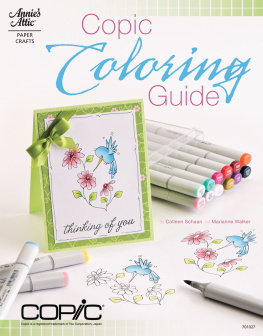

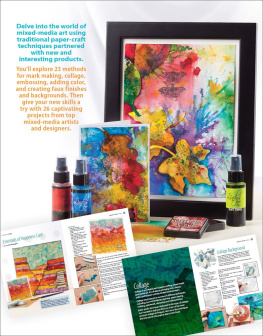
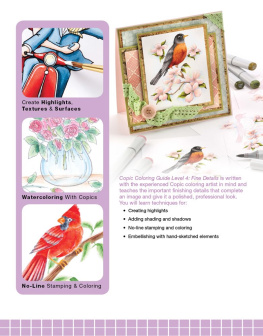
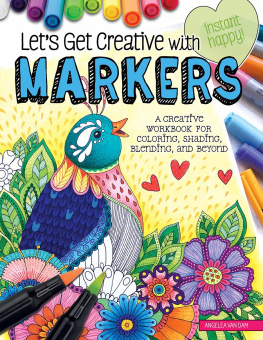

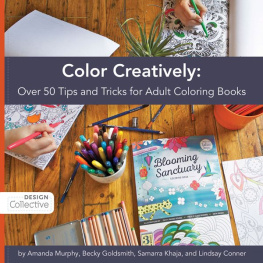
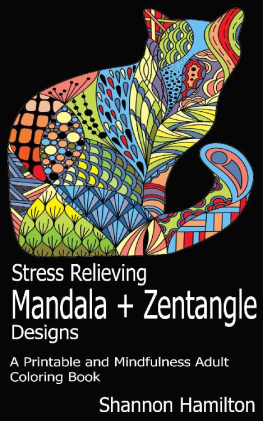
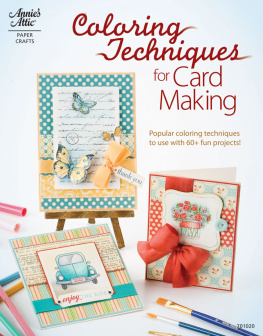


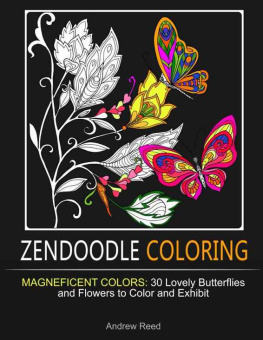
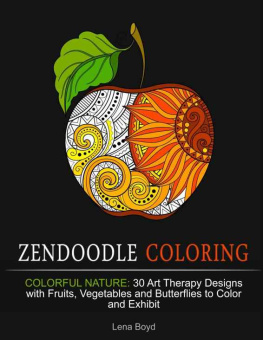

 EDITOR Tanya Fox ART DIRECTOR Brad Snow PUBLISHING SERVICES DIRECTOR Brenda Gallmeyer ASSOCIATE EDITOR Brooke Smith ASSISTANT ART DIRECTOR Nick Pierce COPY SUPERVISOR Deborah Morgan COPY EDITORS Mary ODonnell, Samantha Schneider TECHNICAL EDITOR Corene Painter PHOTOGRAPHY SUPERVISOR Tammy Christian PHOTO STYLISTS Tammy Liechty, Tammy Steiner PHOTOGRAPHY Matthew Owen PRODUCTION ARTIST SUPERVISOR Erin Augsburger GRAPHIC ARTIST Nicole Gage PRODUCTION ASSISTANTS Marj Morgan, Judy Neuenschwander ISBN: 978-1-59635-376-3 Printed in the USA 1 2 3 4 5 6 7 8 9 Copic Coloring Guide is published by DRG, 306 East Parr Road, Berne, IN 46711. Printed in USA. Copyright 2011 DRG. All rights reserved. This publication may not be reproduced in part or in whole without written permission from the publisher. RETAIL STORES: If you would like to carry this pattern book or any other DRG publications, visit DRGwholesale.com.
EDITOR Tanya Fox ART DIRECTOR Brad Snow PUBLISHING SERVICES DIRECTOR Brenda Gallmeyer ASSOCIATE EDITOR Brooke Smith ASSISTANT ART DIRECTOR Nick Pierce COPY SUPERVISOR Deborah Morgan COPY EDITORS Mary ODonnell, Samantha Schneider TECHNICAL EDITOR Corene Painter PHOTOGRAPHY SUPERVISOR Tammy Christian PHOTO STYLISTS Tammy Liechty, Tammy Steiner PHOTOGRAPHY Matthew Owen PRODUCTION ARTIST SUPERVISOR Erin Augsburger GRAPHIC ARTIST Nicole Gage PRODUCTION ASSISTANTS Marj Morgan, Judy Neuenschwander ISBN: 978-1-59635-376-3 Printed in the USA 1 2 3 4 5 6 7 8 9 Copic Coloring Guide is published by DRG, 306 East Parr Road, Berne, IN 46711. Printed in USA. Copyright 2011 DRG. All rights reserved. This publication may not be reproduced in part or in whole without written permission from the publisher. RETAIL STORES: If you would like to carry this pattern book or any other DRG publications, visit DRGwholesale.com.







 There are various ways to add ink to paper. The two most common ways are circling and flicking.
There are various ways to add ink to paper. The two most common ways are circling and flicking.